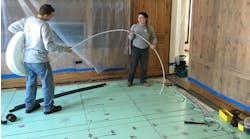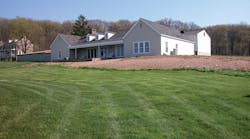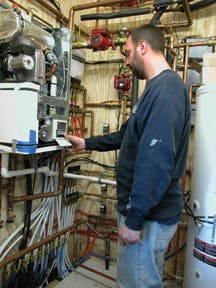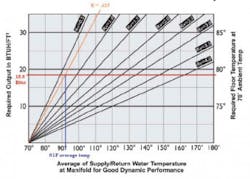'We know what we want for our new home at Gravel Hill: electric radiant heating, electric water heater, and central air- conditioning. We’re open to suggestions if you want to convince us there’s something better or more efficient.’ So said our customer, who provided direction on evaluating heating and cooling options for a new home in eastern Pennsylvania.
Before any equipment options can be considered, however, it’s necessary to build a rock-solid foundation upon which all of the other calculations will rest: the heat loss/gain for the home. I use the Air Conditioning Contractors of America Manual-J program to quickly and efficiently determine the heat loss and gain. Additional loads generated by people, lighting, ventilation, and appliances are added to enhance the accuracy. At 1,860-sq.ft., Gravel Hill’s heat loss equals 34,963 Btuh on a 10°F design day and heat gain of 33,717 Btuh on a 95°F design day.
For an accurate portrayal of equipment first cost and operating cost, we’ll need to project into the future to gauge rising fuel costs. We’ll use historical annual average increases for our calculations. According to the Department of Energy, from 2000 to 2010, annual fuel cost increases averaged:
• 3.5% for electricity
• 3.7% for natural gas
• 9.4% for propane
• 11.0% for oil
In our area in eastern Pennsylvania, we can expect an average 2,250 run-hours for heating and 850 run-hours for cooling. At first glance, this looks like a simple calculation utilizing heat loss/gain, operating hours, and fuel costs, but there are parasitic energy costs that add to customers’ total energy costs that need to be included. For example: blowers and circulators that can be either induction or electrically commutated motor (ECM), and stand-by heat losses for water heaters.
My customer has lived with radiant heating for decades and knows its comfort cannot be rivaled by other types of heating, so radiant was a must-have.
The Fuel Choices
Electric Resistance: If we installed an electric radiant heating, cooling, and water heating system (mirroring their previous home’s mechanical systems), the first year operating costs would look like this:
• $ 2,129.74 for heating
• $ 173.03 for two-stage 16-SEER cooling
• $ 27.54 for the ECM blower
• $ 493.25 for DHW @ 70-gal. per day
The first year’s total is $2,823.56. If we work in the 3.5% annual increase in electricity costs and look 20 years into the future, the total would be $79,849.38.
Oil plus Electric: The same home using an 82% efficient oil-fired boiler and .53EF oil-fired water heater with 13-SEER A/C and an induction blower motor:
• $ 2,135.81 for heating
• $ 27.27 to condition the outdoor air infiltration
used to support combustion
• $ 264.55 for cooling
• $ 70.38 for the induction motor blower
• $ 717.43 for DHW@70-GPD
The first year’s total is $3,215.44, and if we utilize
annual increases of 3.5% for electricity and 11% for fuel oil and look 20 years into the future, the total would be $152,948.61.
Propane: Ninety-five percent modulating condensing boiler with an indirect water heater and 16-SEER two-stage A/C using an ECM blower. The first year operating costs would look like this:
• $ 1,677.28 for heating
• $ 173.03 for two-stage 16-SEER cooling
• $ 27.54 for the ECM blower
• $ 549.33 for DHW @ 70-GPD
The first year’s total is $2,427.19, and if we utilize annual increases of 3.5% for electricity, and 9.4% for propane and look 20 years into the future, the total would be $124,829.24.
Geothermal and Electric: Two-stage water-to-water, 4.34-COP, 21-SEER heat pump with a desuperheater supporting an electric water heater. The first year operating costs would look like this:
• $ 390.09 for heating
• $ 192.00 to power flow-center and zone circulators
• $ 131.84 for two-stage 16-SEER cooling
• $ 27.54 for the ECM blower
• $ 225.00 for DHW @ 70-GPD
The first year’s total is $966.47, and if we figure in annual increases of 3.5% for electricity and look 20 years into the future, the total would be $27,331.46.
Daikin Altherma System: Inverter-drive variable-speed weather responsive air-to-water heat pump, 4.34-COP, 16-SEER with an indirect water heater. The first year operating costs would look like this:
• $ 339.21 for heating (lower cost due to modulation
rather than just two-stage)
• $ 150.46 for cooling (modulation reduces operating costs)
• $ 60.00 for the ECM blower and induction
circulator motors
• $ 103.42 for DHW @ 70-GPD
The first year’s total is $653.09, and if we use annual increases of 3.5% for electricity and look 20 years into the future, the total would be $18,469.18.
First Cost Disappears
As you can see here, the debate is no longer about how expensive the equipment is. The issue becomes either 20-year operating costs of $152,948.61 or 20-year operating costs of $18,469.18. When you put it to your customers that way, going cheap looks foolish.
The only real equipment selection contest here was between the geothermal vs. the Daikin Altherma system. The ECV = $966.47 - $653.09 = $313.08. Twenty-year accumulated ECV = $8,853.80. Geothermal costs would have been approximately $4,000 less due to the 30% federal tax credit (that expires at the end of 2016). The ROI for the Daikin Altherma: ECV ÷ CD = 313 ÷ 4,000 = 7.8%. The owners decided to go with the Daikin Altherma system and chose to buy the solar add-on accessory package.
Inverter technology works like this: 220V single-phase power is converted to 360V D.C. current and passed through capacitors to provide a clean signal. The D.C. power is inverted to 200V simulated three-phase power, which allows all motors to be infinitely varied in speed. Refrigerant is metered as needed to maintain proper superheat and subcooling. The end results are superior dehumidification, an ability to provide heating without a back-up heating source even during bitter cold weather, library-quiet operation, and sipping only the energy required to meet heating/cooling load-requirements at any given moment in time.
The architect specified Warmboard for Gravel Hill installed over sleepers with an R-13 high-density insulation board barrier. PEX-Al-PEX tubing is required, and Warmboard provides an extensive list of compatible brands from which to choose.
Two First Co. variable-speed air handlers with ECM blowers were installed so that programmable thermostats could be used to setback heating and set-up cooling when the owners are away. Under normal operating conditions, the air handlers remain idle as the first-stage radiant heating or cooling managed by the thermostats maintains comfort. A demand exceeding 2°F from the room’s temperature results in the second-stage of heating or cooling to be activated, bringing on one or both air-handlers for rapid recovery from setback/up.
Controlling Radiant Cooling
One hitch was a desire to incorporate limited radiant cooling to enhance comfort and further reduce energy bills. In order to use the Warmboard for radiant cooling, chilled water temperature must be maintained above the dew-point to prevent condensation within the flooring sandwich, which would promote mold growth. This was accomplished by using a thermostatic mixing valve to limit the lowest water temperature the radiant floor circuits will receive and by a humidistat to disable all hydronic chilled-water radiant loops until the second-stage cooling air-handlers have dehumidified to pre-set levels.
Precise dew-point measurements can be determined using a psychometric chart (see www.healthyheating.com/Page%2055/Humidty/chart/index.htm) or by utilizing a chart like the one here: www.buildwithbps.com/assets/downloads/resources/Dewpoint%20Chart.pdf.
If we allow the space to rise up to 85°F during programmed setup, we can assume a rise in humidity will occur. If we have a targeted limit of 50% indoor RH and the humidity rises above that setting, then only the second-stage air-handlers will be permitted to run while dehumidifying and cooling the space. When indoor humidity falls to 50% or lower, the radiant cooling circuits will be allowed to energize, and we are limiting the chilled-water-temperature to a low of 64°F, which provides a comfortable margin of safety. You can find an interactive dew-point calculator here: www.dpcalc.org/.
The next phase will incorporate the addition of solar thermal. The Daikin Altherma system’s indirect water heater will be equipped with a Daikin auxiliary solar heat exchanger that is an add-on accessory for their indirect water heater, and we anticipate harvesting an average of 70% of the DHW to be stored as liquid sunshine. Excess solar energy will be diverted to the radiant heating system during winter and a geothermal loop during the summer. An ASSE-listed thermostatic anti-scald mixing valve is incorporated to limit potable hot water delivery temperature.
Warmboard-enhanced, low-temperature radiant heating, cooling, and solar thermal DHW driven by the highly efficient Daikin Altherma inverter heat pump technology ensures that Gravel Hill will be a sanctuary of comfort for its occupants while their indoor weather is frugally maintained.
Dave Yates is a plumbing contractor. All Dave Yates material in print and online is protected by Copyright ©2012. Any reuse of this material (print or electronic) must first have the expressed written permission of Dave Yates and CONTRACTOR magazine. Contact via email at: [email protected].




